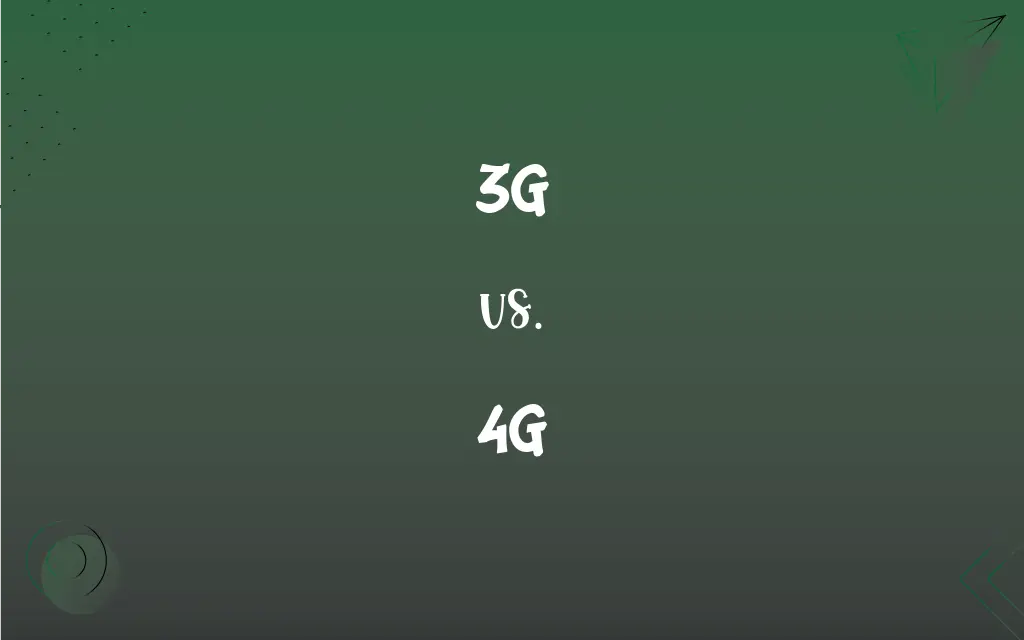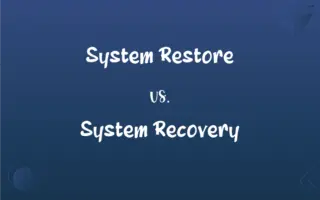3G vs. 4G: What's the Difference?
Edited by Aimie Carlson || By Harlon Moss || Updated on October 24, 2023
3G is the third generation of mobile networks, offering faster speeds than 2G, while 4G is the fourth generation, providing even higher data rates and improved performance.

Key Differences
3G, standing for the third generation, marked a significant improvement in mobile telecommunications, offering faster internet browsing, clearer call quality, and multimedia use. 4G, on the other hand, stands for the fourth generation, elevating data speeds and network capabilities even further.
While 3G networks primarily improved the mobile internet experience compared to 2G, they still had limitations in terms of data streaming and connection stability. 4G addresses these gaps, providing smoother streaming, lower latency, and enhanced mobile broadband services.
One notable advantage of 3G was its introduction of video calling and mobile TV, changing the way users consumed content. However, 4G took these advancements in stride, allowing for high-definition mobile streaming, online gaming, and seamless video conferencing.
The infrastructure for 3G was revolutionary at its time, bridging the gap between mobile and internet. 4G, meanwhile, built on this foundation, utilizing advanced technologies like LTE (Long-Term Evolution) to drive faster and more reliable connections.
When 3G emerged, it became the standard for mobile communication, enabling more advanced applications and services. 4G, with its superior speed and efficiency, has since become the gold standard, paving the way for the current push towards 5G networks.
ADVERTISEMENT
Comparison Chart
Generation
Third generation of mobile networks
Fourth generation of mobile networks
Data Speeds
Faster than 2G, but slower than 4G
Significantly faster than 3G
Key Features
Video calling, mobile TV
HD streaming, high-speed mobile broadband
Underlying Technology
CDMA, UMTS
LTE, WiMAX
Latency
Higher latency than 4G
Reduced latency
ADVERTISEMENT
3G and 4G Definitions
3G
A technology that improved mobile data transmission rates.
With 3G, I finally got to enjoy smoother video calls.
4G
The generation introducing fastest mobile browsing before 5G.
With 4G, online mobile gaming became a more enjoyable experience.
3G
Third generation of cellular mobile communications.
My older phone operated on the 3G network, making internet browsing slower.
4G
Fourth generation of cellular mobile communications.
My new smartphone is compatible with the 4G network, offering faster download speeds.
3G
A mobile network standard following 2G and preceding 4G.
Most countries transitioned from 2G to 3G in the early 2000s.
4G
A system that utilizes LTE or WiMAX technologies.
4G networks, especially those using LTE, have significantly reduced latency.
3G
A mobile communications system supporting multimedia applications.
3G changed the way we consumed online content on mobile devices.
4G
A mobile network standard that succeeded 3G.
Many urban areas transitioned to 4G for better mobile broadband services.
3G
A leap from voice-centric services to mobile internet.
The shift to 3G made mobile web browsing a mainstream activity.
4G
A technology ensuring high-speed mobile internet.
Streaming HD videos became seamless with 4G connectivity.
FAQs
What does 3G stand for?
3G stands for the third generation of mobile telecommunications technology.
Did 4G completely replace 3G?
While 4G became more dominant, 3G networks are still operational in many areas.
What's the primary technology behind 4G?
4G primarily utilizes LTE (Long-Term Evolution) technology.
Which is more efficient for HD streaming, 3G or 4G?
4G is more efficient and suitable for HD streaming.
Was mobile TV a feature of 3G?
Yes, mobile TV was one of the features introduced with 3G.
How do data plans differ for 3G and 4G?
4G data plans are often tailored for higher data consumption due to faster speeds, whereas 3G plans might have been more limited.
Was video calling introduced with 3G?
Yes, 3G played a pivotal role in popularizing video calling.
Does 4G consume more battery than 3G?
Due to higher data speeds and activity, 4G can consume more battery under heavy usage.
Are all modern smartphones 4G compatible?
Most modern smartphones are 4G compatible, but it's always good to check specifications.
Was internet browsing feasible on 3G?
Yes, 3G made mobile internet browsing mainstream and more efficient.
Which network is better for online gaming, 3G or 4G?
4G, with its faster speeds and reduced latency, is better for online gaming.
Was 3G a global standard?
3G became a global standard, but its implementation varied across regions.
Is 4G the latest mobile network generation?
No, 4G is succeeded by 5G, which is the latest generation as of now.
How does 4G perform in terms of voice call quality?
4G, especially with VoLTE, offers clearer voice call quality compared to 3G.
Can a 4G phone work on a 3G network?
Yes, most 4G phones are backward compatible and can work on 3G networks.
What was a significant benefit of 3G over its predecessor?
3G bridged the gap between voice services and mobile internet, offering faster browsing and multimedia applications.
How is 4G different from 3G in terms of speed?
4G offers significantly faster data speeds compared to 3G.
How does latency compare between 3G and 4G?
4G generally offers lower latency compared to 3G.
Which came first, 3G or 4G?
3G came before 4G.
Did 3G improve multimedia services?
Yes, 3G brought significant improvements to multimedia services like video calling.
About Author
Written by
Harlon MossHarlon is a seasoned quality moderator and accomplished content writer for Difference Wiki. An alumnus of the prestigious University of California, he earned his degree in Computer Science. Leveraging his academic background, Harlon brings a meticulous and informed perspective to his work, ensuring content accuracy and excellence.
Edited by
Aimie CarlsonAimie Carlson, holding a master's degree in English literature, is a fervent English language enthusiast. She lends her writing talents to Difference Wiki, a prominent website that specializes in comparisons, offering readers insightful analyses that both captivate and inform.































































